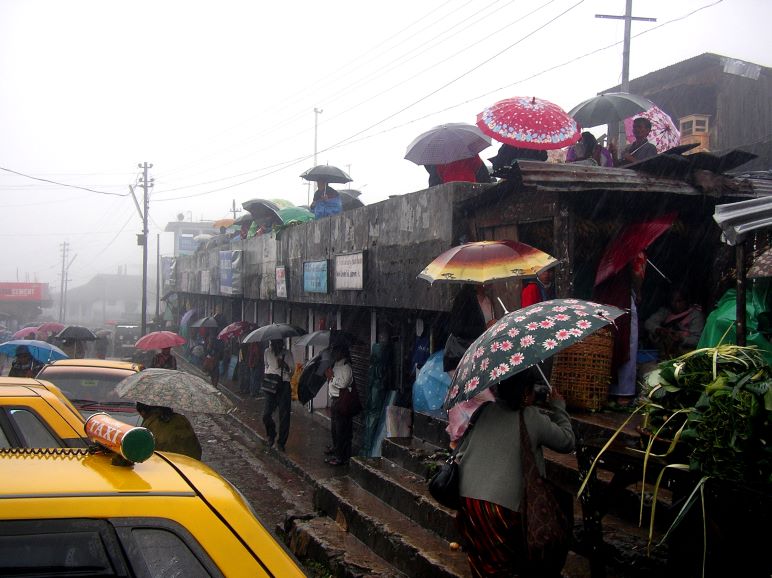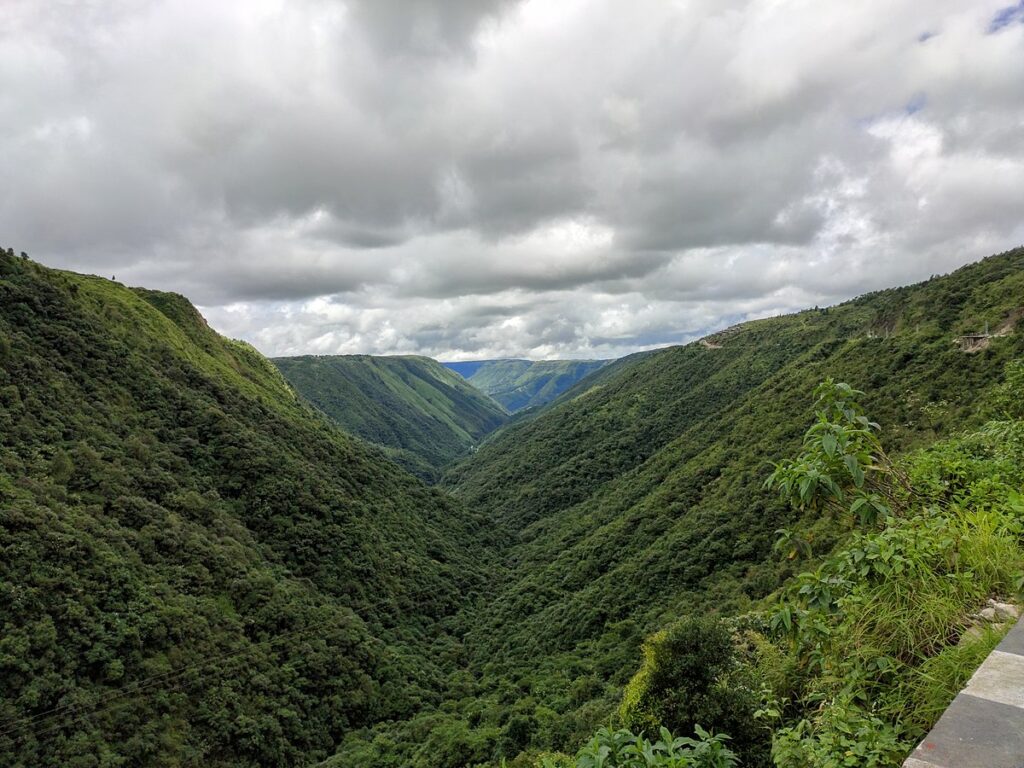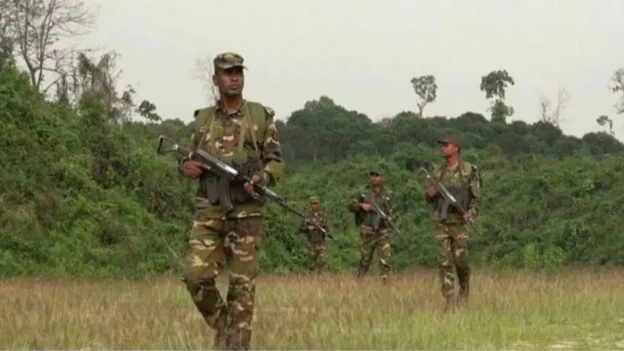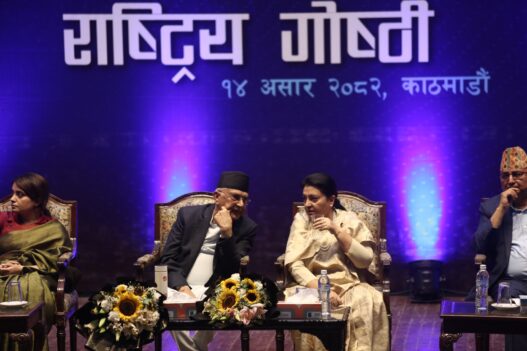Amidst the picturesque landscape of Sohra, also known as Cherrapunjee, a remarkable climatic transformation has taken center stage, captivating both residents and visitors alike. Sohra, renowned as the wettest place on Earth, has now found itself in a battle between two elemental forces of nature. As rainfall relinquishes its dominance, it finds itself navigating uncharted territory as the scorching heatwaves gain prominence.
Sohra: The Wettest Place on Earth
For centuries, Sohra, nestled in the northeastern state of Meghalaya in India, has held an unparalleled reputation as a haven for perpetual rain. It holds two Guinness World Records for its rainfall. In a single year, between August 1860 and July 1861, Sohra received a staggering 26,471 millimeters (1,042.2 inches) of rainfall, securing its place in history. Additionally, it holds the record for the maximum amount of rainfall in a single month, with 9,300 millimeters (370 inches) in July 1861.
Shifting Climatic Dynamics
Nearby Mawsynram, often considered the wettest place on Earth, boasts an average annual rainfall of 11,872 millimeters (467.4 inches). In 1985, it even received an extraordinary 26,000 millimeters (1,000 inches) of rainfall, as recorded in the Guinness Book of World Records.
However, a shift in Sohra’s climatic dynamics has left its residents perplexed. The once-reliable rainfall has been overshadowed by the onslaught of scorching heatwaves, emerging as a formidable adversary. As umbrellas, once symbols of protection from rain, now become shields against the sweltering rays, the people of Sohra find themselves navigating uncharted territory, adapting to a new reality.

Unprecedented Closure of Educational Institutions
For the first time in history, Meghalaya, known for its pleasant weather and ample rain, had to announce the closure of all educational institutions in parts of the state due to a heatwave. This unprecedented step was taken to safeguard the students and staff from the scorching heat that had engulfed the region.
Meghalaya’s Education Minister, Rakkam A. Sangma, expressed his concerns about the rising temperatures and issued advisories to close down educational institutions in the West Garo Hills and South Garo Hills districts. The safety and well-being of the students were of paramount importance, prompting this extraordinary measure.
Record Rainfall and the Changing Trend
Last year, on June 17, Sohra experienced its third-highest recorded rainfall in history. Examining the historical data dating back to 1901, the rainfall measurement of 972 millimeters on that day marked the city’s third-highest recorded figure in the past 122 years. Although the region still receives rainfall, the previous record remains unbroken.
The Indian Meteorological Department (IMD) reveals a troubling trend. Sohra has been losing an average of 27.15 millimeters of annual rainfall each year, mirroring a similar phenomenon observed in Mawsynram.
Acute Water Shortages in a Rainfall Abundant Region
Ironically, despite being one of the wettest places on the planet, Sohra grapples with acute water shortages. Around 40 percent of the region’s residents face a scarcity of potable water. Stephan Khongsit, a resident of Khlieh Shnong Sohra, laments how people are forced to purchase water from private tankers at exorbitant costs during dry and winter seasons. The region’s water supply system, commissioned in 2003 to cater to a smaller population, now struggles to meet the demands of rapid urbanisation.
Contrasting Landscapes: Forests and Human Habitation
Travelling through Sohra, one can witness a curious sight. While the southern parts of the region, bordering Bangladesh and South West Khasi Hills, boast pockets of dense forest vegetation, human habitation areas lack significant green cover. Batskhem Khongjee explains that Sohra never had vast forests, except in the southern regions.
Climate Change Challenges in Sohra, India
Stephan Khongsit says, during dry seasons people are forced to walk several kilometres to avail water till date as the public health engineering (PHE) has not revamped the water supply system in the region. He recalled that the water supply which was commission way back in 2003 aims to cater to a small population but now cannot serve the purpose with the ever growing of urbanisation.
Multifaceted Causes of Sohra’s Water Scarcity
The reasons behind Sohra’s water scarcity are multifaceted. The impact of global warming, urbanisation, industrialisation, limestone and sand mining, and other factors has contributed to the decline in rainfall.
Environmentalist’s Perspective on Rainfall Decline
Environmentalist Morningstar Khongthaw, highlights the detrimental effects of rampant deforestation and the changing sea surface temperature He asserts, “The increasing urbanisation and industrialisation has had a detrimental effect, diminishing the soil’s ability in these areas to retain the rainfall that Sohra continues to receive each year.”
Impact of Deforestation and Sea Surface Temperature
Khongthaw points out that widespread deforestation and shifts in sea surface temperature have largely contributed to the decline in rainfall, affecting not only Meghalaya but also Sohra.
Demographic Factors and Water Overflow
He further explains that the demography of Sohra, distinct from that of Mawsynram, lacks dense vegetation, trees, and significant reservoirs, resulting in rainwater overflow to Bangladesh. This phenomenon becomes particularly evident during the dry season when springs dry up, leading to water shortages.
Power Supply Challenges and Delayed Monsoon
According to Meghalaya Tourism minister, Paul Lyngdoh, the delayed onset of the monsoon season adversely affects the state’s power supply.
In a recent press release, the Director of the Meghalaya Power Distribution Corporation Limited (MPDCL) attributed the ongoing load shedding in the state since April 2023, to the outages of power stations operated by the North Eastern Electric Power Corporation (NEEPCO). These outages resulted in a reduction of approximately 45 MW in Meghalaya’s power supply. Furthermore, the Director highlighted that the water level at the Umiam reservoir is currently at its lowest point this year compared to previous years. This decline is attributed to the insufficient rainfall experienced across the state and the broader region, which has adversely affected all power stations situated in the Umiam Basin and the Myntdu Leshka.
Sohra’s Attractiveness and Tourism
However, despite these challenges, Tourism Minister Lyngdoh affirms that Sohra remains a captivating destination for tourists. Moreover, this has led to a substantial influx of tourists to Meghalaya, specifically to renowned destinations like East Khasi Hills, West Khasi Hills, Jaintia Hills, and other areas within the Garo Hills. The sweltering heat experienced in the plains has prompted many to seek solace in Meghalaya, with Sohra emerging as the top destination among domestic tourists.

Kong Nongkhlaw, a vendor selling corn at Mawkdok, affirms that despite the drying up of many seasonal waterfalls, Sohra continues to attract tourists even on weekdays. Nongkhlaw notes, “I am here every day, and even though the number of tourists is lower on weekdays, people still come to Sohra. However, during weekends, the influx of tourists becomes uncountable.”
Similarly, an elderly man affectionately known as Bahduh, selling wild orchids at the junction of Sohra Market, expressed confusion about the annual rainfall pattern each year. Due to his old age, he could not recall the exact month when monsoon began in Sohra or Meghalaya as a whole.
As umbrellas continue to dot the streets of Sohra, their purpose has shifted from shielding the people from torrential rains to providing relief from the heat, now, serving as a poignant symbol of climate change.
Sohra continues to be known as the wettest place on Earth, as residents brace themselves against the heat, waiting for the return of their cherished rainfall, the gentle pitter-patter that brings life and vitality to their beloved land, the abode of clouds.
Conclusion:
Sohra, the wettest place on Earth, is facing water scarcity and power supply issues due to climate change. Factors like deforestation, urbanization, and changes in sea surface temperature have contributed to the decline in rainfall. Despite these challenges, Sohra remains a popular tourist destination. However, the impact of climate change is evident, as seasonal waterfalls dry up and umbrellas serve as symbols of shifting weather patterns. Addressing these challenges is crucial for the sustainable development of Sohra and preserving its unique ecosystem.
Frequently Asked Questions (FAQs):
Q1: Why is Sohra facing water scarcity?
A1: Sohra’s water scarcity is attributed to factors such as urbanization, deforestation, and changes in rainfall patterns due to climate change.
Q2: What are the main factors contributing to the decline in rainfall in Sohra?
A2: The decline in rainfall in Sohra is influenced by factors such as deforestation, urbanization, industrialization, limestone and sand mining, and shifts in sea surface temperature.
Q3: How does Sohra’s water scarcity affect the local population?
A3: Water scarcity in Sohra forces people to walk long distances to access water during dry seasons. The inadequate water supply system and growing urbanization have exacerbated the problem.
Q4: How does climate change affect Sohra’s rainfall?
A4: Climate change impacts Sohra’s rainfall patterns by diminishing the soil’s ability to retain rainfall and leading to water overflow to neighboring regions. Deforestation and changes in sea surface temperature also contribute to the decline in rainfall.
Q5: How does Sohra’s water scarcity affect power supply in the region?
A5: Insufficient rainfall and low water levels in reservoirs have resulted in power outages and load shedding in Meghalaya. Power stations dependent on adequate water supply are adversely affected.
Q6: Is Sohra still a popular tourist destination despite these challenges?
A6: Yes, Sohra continues to attract tourists, especially during weekends, despite drying waterfalls and changing weather patterns. Its unique landscape and charm make it a captivating destination.
Q7: How are residents coping with the changing climate in Sohra?
A7: Residents of Sohra are adapting to the challenges posed by climate change, such as relying on umbrellas for heat protection and seeking alternative water sources. They eagerly await the return of the cherished rainfall.
Q8: What steps are being taken to address the water scarcity and power supply issues in Sohra?
A8: Efforts are being made to revamp the water supply system and address the impacts of climate change through conservation measures, afforestation, and sustainable development initiatives.
Q9: What is the significance of umbrellas in Sohra?
A9: Umbrellas in Sohra serve as symbols of climate change as their purpose has shifted from shielding people from rain to providing relief from the heat. They represent the changing weather patterns in the region.
Q10: What is the future outlook for Sohra’s water availability and climate?
A10: Ensuring water availability and addressing climate change impacts are essential for the sustainable development and preservation of Sohra’s unique ecosystem. Continued efforts are needed to mitigate these challenges and promote resilience in the region.







